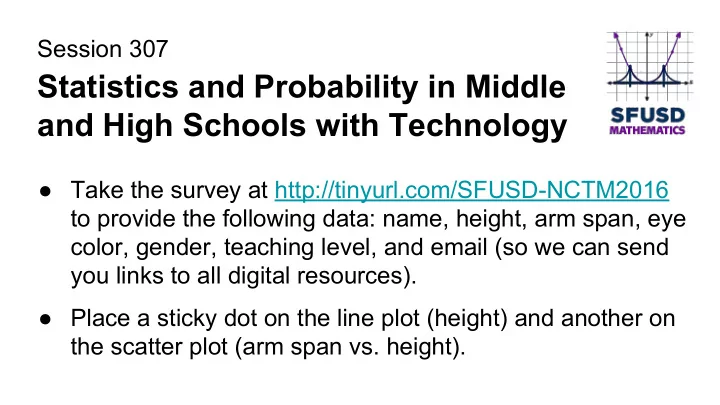

Session 307 Statistics and Probability in Middle and High Schools with Technology ● Take the survey at http://tinyurl.com/SFUSD-NCTM2016 to provide the following data: name, height, arm span, eye color, gender, teaching level, and email (so we can send you links to all digital resources). ● Place a sticky dot on the line plot (height) and another on the scatter plot (arm span vs. height).
@SFUSDMath Agenda #NCTM16 #NCTMannual ● Univariate Statistics ○ Median-based (median, IQR, box plots, histograms) ○ Mean-based (mean, standard deviation, normal curve) ● Bivariate Statistics ○ Numerical (line of best fit, residuals, LSRL) ○ Categorical (two-way tables, association) ● Probability (simulations) ● Digital tools: TinkerPlots, spreadsheets, Desmos, Fathom
Univariate Statistics: Median-based ● Determining median and quartiles ● Making a box plot ○ Whiskers: entire range or last data point within 1.5 • IQR? ○ Quartiles: include or exclude median? ● Box plots and histograms using TinkerPlots ● Relating histograms and box plots demo
Univariate Statistics: Mean-based ● Calculating standard deviation with a Google spreadsheet ● Sketching a normal curve ● Plotting a normal curve in Fathom ● Transforming a normal curve in Desmos ● Area under a normal curve
Normal Curve: The Empirical Rule
Univariate Statistics Representing Data ● dot plots Unit 6.6 – Distributions and Variability ● histograms ● box plots Measures of Center ● median Unit 6.6 – Distributions and Variability ● mean Measures of Spread ● range Unit 6.6 – Distributions and Variability ● interquartile range ● mean absolute deviation ● standard deviation Unit A.7 – Categorical and Quantitative Data Comparing Groups ● informal inferences Unit 7.7 – Samples and Probability Normal Curve ● normal distributions Unit A2.6 – Statistics: Random Processes ● population percentages ● margin of error ● inferences
Bivariate Statistics: Numerical ● From univariate to bivariate representations in TinkerPlots ● Line of best fit (spaghetti method) ● Least Squares demo ● Linear regression using Desmos ● Least squares in Fathom
Bivariate Statistics: Categorical ● Two-way tables ○ gender vs. teaching level ○ gender vs. eye color ● Determining association ● Two-way tables using Titanic data in TinkerPlots
Gender vs. teaching level Fill in the counts in two-way table. MS HS Total Female 9 11 20 Male 4 7 11 Total 13 18 31 Calculate row percents or column percents.
Row Percentages Percent of each gender that is a particular teaching level. Total of each gender is denominator. MS HS Total Female 45% 55% 100% Male 36% 64% 100% Total 42% 58% 100%
Column Percentages Percent of each teaching level that is female or male. Total of each teaching level is denominator. MS HS Total Female 69% 61% 65% Male 31% 39% 35% Total 100% 100% 100%
Gender vs. eye color Fill in the counts in two-way table. Brown Hazel Blue Total Female 12 3 6 21 Male 5 3 3 11 Total 17 6 9 32 Calculate row percents or column percents.
Row Percentages Percent of each gender that has particular eye color. Total of each gender is denominator. Brown Hazel Blue Total Female 57% 14% 29% 100% Male 45% 27% 27% 100% Total 53% 19% 28% 100%
Bivariate Statistics Representing Data ● two-way tables Unit 8.8 – Bivariate Data ● scatter plots Linear Models ● line of best fit Unit 8.8 – Bivariate Data ● interpreting slope ● residual plots Unit A.7 – Categorical and Quantitative Data ● correlation coefficient
Probability Probability Models ● random sampling Unit 7.7 – Samples and Probability ● sample space ● relative frequencies Compound Events ● lists, tables, tree diagrams Unit 7.7 – Samples and Probability ● simulations ● weighted tree diagrams, area Unit G.9 – Probability models Conditional Probability ● independence of events Unit G.9 – Probability ● conditional probabilities ● addition and multiplication rules (+) ● expected value (+)
From 6–8 Statistics and Probability Progression (page 7): It must be understood that the connection between relative frequency and probability goes two ways. If you know the structure of the generating mechanism (e.g., a bag with known numbers of red and white chips), you can anticipate the relative frequencies of a series of random selections (with replacement) from the bag. If you do not know the structure (e.g., the bag has unknown numbers of red and white chips), you can approximate it by making a series of random selections and recording the relative frequencies. This simple idea, obvious to the experienced, is essential and not obvious at all to the novice. The first type of situation, in which the structure is known, leads to “probability”; the second, in which the structure is unknown, leads to “statistics.”
Digital Tools • TinkerPlots ( http://www.tinkerplots.com ) • Fathom ( http://fathom.concord.org ) • Desmos ( http://www.desmos.com ) • Relating Histograms and Box Plots Demo: http://higheredbcs.wiley. com/legacy/college/mann/0470444665/applets/applet_01_v4.html • Google spreadsheets ( standard deviation example ) • Least Squares Demo: https://www.desmos.com/calculator/zvrc4lg3cr • Transforming a Normal Curve: https://www.desmos.com/calculator/9l7kec7fof • Rossman/Chance Applet Collection ( http://www.rossmanchance.com/applets ) • Tuva Labs ( https://tuvalabs.com ) • Today’s Data: https://drive.google.com/drive/folders/0B7g5_AlX0zNyWlI1OVRUN2hZSlk
Thank you! Andres Marti HS Math Content Specialist martia@sfusd.edu www.sfusdmath.org Elizabeth DeCarli HS Math Content Specialist decarlie@sfusd.edu @SFUSDMath Alison Ellsworth #NCTM16 MS Math Content Specialist #NCTMannual ellswortha@sfusd.edu
Recommend
More recommend